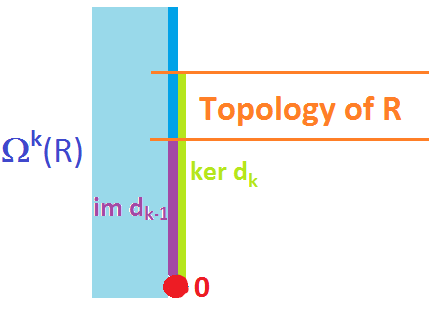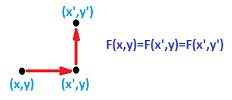This site is being phased out.
Closed and exact forms
We now approach the topological aspects of the theory of differential forms.
Some linear algebra
Before we proceed we need some new linear algebra...
Consider: $$X \stackrel{A}{\rightarrow} Y \stackrel{B}{\rightarrow} Z.$$ This is a sequence of vector spaces and linear operators.
Suppose $$BA=0.$$ Let's restate this in terms of subspaces of $X,Y$.
Recall from linear algebra, that each linear operator produces two vector spaces:
Then we can restate $$BA=0$$ as $${\rm im} A \subset \ker B.$$ Note that these are subspaces of $Y$.
Further, a sequence $X \stackrel{A}{\rightarrow} Y \stackrel{B}{\rightarrow} Z$ is called exact if $${\rm im} A = \ker B.$$ So, not just a subset but
To relate this to something you've seen before consider this...
Example: Let $G$ be a vector space and $H$ a linear subspace of $G$. Then, $$H \stackrel{i}{\rightarrow} G \stackrel{q}{\rightarrow} G/H$$ is exact, where $i$ denotes the inclusion and $q$ denotes the quotient function. Here's how it works: $$qi \colon x \mapsto x \mapsto [x].$$
Closed and exact differential forms
What does ${\rm im} A \subset \ker B$ have to do with differential forms?
Recall a big theorem we have proved for dimension $3$ only:
Theorem (Topological property of exterior derivative). If $\varphi$ is a $C^2$-form in $\Omega ^k({\bf R}^n)$, then $d_{k+1}(d_k \varphi)=0$ (we can also write as $dd=0$ or $d^2 = 0$).
Proof: As before, assume $\varphi = A dX$ (and use linearity later), where $dX$ is a basis $k$-form (i.e., wedge product and $A=A(x^1,...,x^n)$ is a coefficient function, twice continuously differentiable. Then, using the definition of exterior derivative and its formula for $0$-forms we have: $$\begin{align*} d \varphi &= d(A dX) \\ &= dA \wedge dX) \\ &=\left( \sum _{i=1}^{n} A_i dx^i \right) \wedge dX \\ &=\sum _{i=1}^{n} A_i \left( dx^i \wedge dX \right). \end{align*}$$ Next, $$\begin{align*} d (d \varphi) &= d \left( \sum _{i=1}^{n} A_i dx^i \wedge dX \right) \\ {\rm (linearity)} &= \sum _{i=1}^{n} d \left( A_i dx^i \wedge dX \right) \\ {\rm (definition)} &= \sum _{i=1}^{n} [ d A_i ] \wedge dx^i \wedge dX \\ {\rm (formula)} &=\sum _{i=1}^{n} \left[ \sum _{j=1}^{n} A_{ji} dx^j \right] \wedge dx^i \wedge dX \\ &= \left[ \sum _{i=1}^{n} \sum _{j=1}^{n} A_{ji} dx^j \wedge dx^i \right] \wedge dX . \end{align*}$$ Next we need to show that $[...]=0$. It is the case because of anti-symmetry and the fact that mixed derivatives are equal:
- each pair $(i,j)$ with $i\ne j$ appear twice in the sum -- in the opposite order, so they cancel;
- pairs $(i,i)$ appear $n$ times with each equal to $0$.
We can see this effect if we put the terms of the sum in a table: $$ \begin{array}{llllllllllll} & & ... & i & ... & j & &\\ &... & ... & ... & ... & ... &\\ & i & ... & A_{ii}dx^idx^i & ... & A_{ji}dx^jdx^i& &\\ & ...& ... & ...& ... & ...& &\\ & j & ... & A_{ij}dx^idx^j & ... & A_{jj}dx^jdx^j & &\\ \end{array} $$ $\blacksquare$
Sidenote: compare $dd=0$ to the homology's $\partial \partial = 0$.
Some forms satisfy this property even though they aren't $C^2$ (cf. Discrete differential forms).
The property $\ker d \subset {\rm im} d$ of our sequence $$... \xrightarrow{d_{k-2}} \Omega^{k-1} \xrightarrow{d_{k-1}} \Omega^{k} \xrightarrow{d_{k}} \Omega^{k+1} \xrightarrow{d_{k+1}} \Omega^{k+2} \xrightarrow{d_{k+2}} ... ,$$ can be graphically illustrated by:
We will deal with the kernel and the image separately, for now.
Definition: If $d \varphi = 0$, then $\varphi$ is called closed.
Definition: If for some $\psi$, $\varphi = d \psi$, then $\varphi$ is called exact.
So,
- $\ker d_k$ is the set of all closed $k$-forms;
- ${\rm im} d_{k-1}$ is the set of exact $k$-forms.
All are subspaces: $${\rm im} d_{k-1} < \ker d_k < \Omega^{k}.$$
The above theorem can be restated as...
Theorem: All exact forms are closed.
When the converse is true, all closed forms are exact, then the sequence is exact. In this case, as we shall see, the topological features of $R$, of this dimension, are absent. In fact, it is in the "gap" between ${\rm im} d_{k-1}$ and $\ker d_k$ where information about the topology of $R$ is to be found:
However, the gap between a vector space $V$ and its subspace $U$ cannot be evaluated by looking at the gap $V-U$ itself as this isn't a subspace. A better approach to evaluating the difference between $V$ and $U$ is to look at the difference of their dimensions $$\dim V -\dim U.$$ Unfortunately, in this setting the dimensions of ${\rm im} d_{k-1}$ and $\ker d_k$ are typically infinite. That's why it is necessary to deal with their quotient, $$\ker d_k / {\rm im } d_{k-1}$$ called the de Rham cohomology.
Before we deal with this vector space in full generality we address the two vector spaces separately, for low values of $k$.
Closedness and exactness of $0$-forms
Let's first review what we know about $0$-forms over ${\bf R}$.
Question: When is a $0$-form closed? I.e., $d \varphi^0=0$?
Answer: When $\varphi^0$, a function, is constant.
Theorem. A $0$-form in ${\bf R}$ is closed if and only if it is constant.
Proof. ($\Rightarrow$) If $\varphi^0$ is constant, then $d\varphi^0 = 0$, so $\varphi$ is closed.
($\Leftarrow$) Suppose $d\varphi^0 = 0$ and suppose $\varphi^0 = f \in C^1$. In ${\bf R}^1$, $df(x) = f'(x) dx = 0 dx =0$. Then by a certain corollary to the Mean Value Theorem $f$ has to be constant. $\blacksquare$
What about something more general than ${\bf R}$?
We consider $\Omega^k({\bf R})$, which is the space of forms with domains in an open region $R$.
Observation: This theorem works for $\Omega^0({\bf R})$, and for $\Omega^0((0,1))$ and $\Omega^0((2,3))$, but it does not work for $\Omega^0((0,1) \cup (2,3))$
Indeed, consider $$f(x) = \begin{cases} 1, & \mbox{for } x \in (0,1),\\ 2, & \mbox{for } x \in (2,3). \end{cases}$$ It is not constant, but $df = 0$.
So, when does it work?
The proof certainly works for any interval!
But in ${\bf R}$ every path-connected subset is an interval. So, maybe this is what it's all about...
Proposition. If the domain $R \in {\bf R}^n$ is (path-)connected, then closed $0$-forms are constant functions (and vice versa).
What about exact $0$-forms?
Too easy: $\varphi^0 = d \psi^{-1}$ (where $-1$ is the degree of the form), but all $\psi^{-1}=0$, so $\varphi^0=0$.
It follows then:
Proposition. The only exact $0$-form in ${\bf R}^n$ is $0$.
Things are more complicated if we move to multidimensional spaces.
However, even in ${\bf R^n}$ we still have
Theorem: Constant forms are closed.
Proof. Easy. $\blacksquare$
Theorem: If the domain $R$ is open and path-connected, closed $0$-forms are constant.
Proof. The proof is for ${\bf R^2}$ but equally applicable to all dimensions.
Suppose $R$ is the domain and $F$ is a closed $0$-form, i.e., just a function of two variables. Then $\nabla F(dx,dy) = 0$, so $\nabla F =0$, and therefore $F_x=0$ and $F_y=0$. Then we have the following.
- (1) $F_x=0$ for all $(x,y) \in R$. Hence, $F$ is constant with respect to $x$ on $R$.
- (2) $F_y=0$ for all $(x,y) \in R$. Hence, $F$ is constant with respect to $y$ on $R$.
So what?
- (1) $\Rightarrow$ $F$ is constant on the segments that are $R \cap {\rm horizontal \hspace{3pt} lines}$; with possibly different constants!
- (2) $\Rightarrow$ $F$ is constant on the segments that are $R \cap {\rm vertical \hspace{3pt} lines}$; with possibly different constants!
What we have shown is that $F$ is constant on each of these segments:
Constant are different but we can make turns -- without changing the value of $F$:
So, if there is a path between $(x_0,y_0), (x_1,y_1)$ made of horizontal and vertical segments, then $F(x_0,y_0) = F(x_1,y_1)$. How can we use this?
Idea: approximate the path with a step-like path with the same endpoints.
This is possible because the domain, $R$, is open. Details here: Approximating paths. $\blacksquare$
The proof won't work if $R$ isn't open. However, this isn't a real restriction because we usually avoid doing calculus on domains that aren't open so that the derivative is always well defined.




